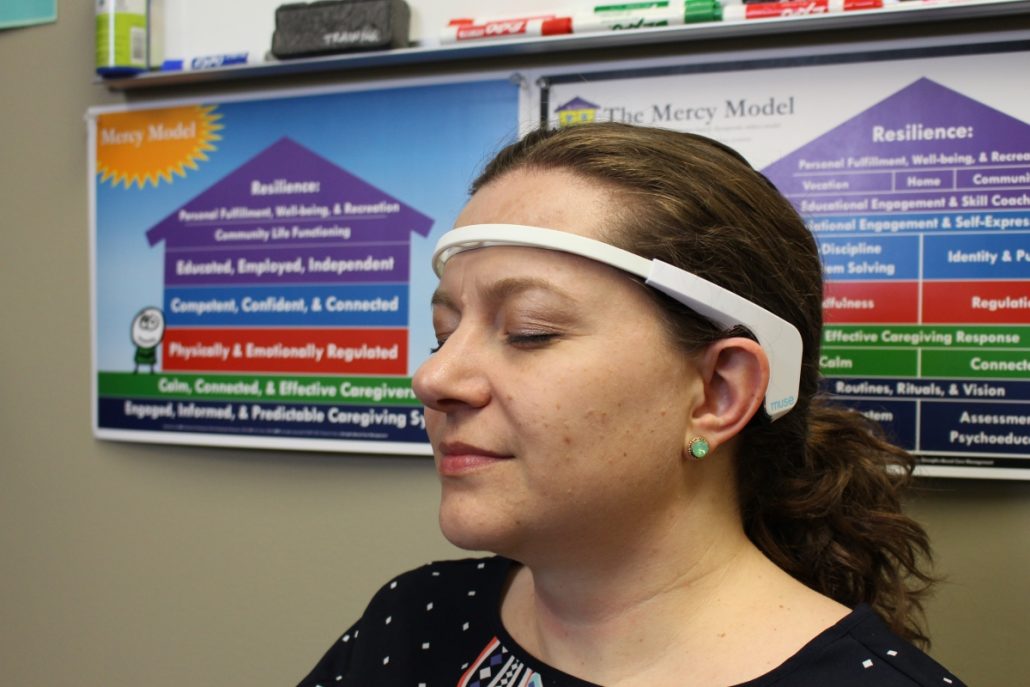Digital Detox: Helping Teens Unplug in a Virtual World
Young people are spending more time in front of their screens than ever, but how do you help them find...
February 11, 2025

Mercy Home for Boys & Girls is investing in innovative neurofeedback technology called electroencephalography, or EEG. It incorporates brain sensors and computer games to help our kids self-regulate their energy and emotions. This safe, non-invasive therapeutic tool is being integrated into our Mercy Model of Care and represents a bold step forward in serving the mental and behavioral health needs of our children.

“EEG Neurofeedback provides a mirror to your mental state – a mirror to the mind,” said Jeremy Karpen, Mercy Home’s Director of Learning & Development. “It is a specialized form of biofeedback which allows a person to receive real-time feedback on their emotional and cognitive state.”
By placing sensors on a person’s head, the electrical impulses generated by the brain’s firing neurons can be detected, amplified, and displayed on a computer screen.
“The intensity and pattern of this firing looks different if one is actively thinking, worrying, calm, focused, daydreaming, or falling asleep,” said Karpen.
Those signals can then be fed into an interactive video game. This not only gives the individual a glimpse of their brain activity, more importantly, it makes them aware of their mental state. Ultimately, this helps the person learn effective strategies for self-regulation by shifting their state of mind.



“In the video game, you challenge yourself to make Pac-Man move, or to drive a rocket ship, but not with a controller,” said Karpen. “Instead, you move the characters by changing your mental state – changing the pattern of firing in your brain as shown in your EEG.”
With neurofeedback, Mercy Home hopes to give youth a fun and effective strategy for learning to regulate their energy and emotions.
“Ultimately, we believe that this intervention has the ability to improve functioning across a variety of domains, and, for some youth, may decrease their reliance on medication,” said Karpen.
The EEG Neurofeedback initiative is guided by Mercy Home’s implementation of the Neurosequential Model of Therapeutics (NMT) into our Mercy Model of Care. The NMT includes an assessment that gives a clearer picture of a youth’s developmental stage and provides corresponding recommendations for helpful therapeutic interventions.
The assessment also helps determine whether a youth is developmentally ready to benefit from traditional ‘talk therapy,’ or if more non-verbal, body-based approaches would be more effective, such as those found in EEG Neurofeedback or Sensory Motor Arousal Regulation Treatment (SMART). Mercy Home began implementing SMART therapy in 2017. Its tactile approaches use sensory integration, via tools such as weighted blankets and trampolines, to treat regulation in adolescents through active therapy in a room which allows for movement and play.
“Both SMART and Neurofeedback can function as adjunctive trauma treatments that are less reliant on verbal processing,” said Karpen. “They both help to establish a calm, rhythmic, and engaged mental state that is, in and of itself beneficial, but also allows a youth to become ‘more ready’ for processing and learning.”
Mercy Home coworkers completed a four-day training in EEG Neurofeedback from Dr. Ed Hamlin and Dr. Mary Ammerman from EEG Education and Research. Mercy Home will be purchasing seven sets of EEG equipment to be shared among programs and used in the treatment of our kids.
Young people are spending more time in front of their screens than ever, but how do you help them find...
February 11, 2025
Healthy communication in the family system is incredibly important, yet sometimes it can feel hard to achieve. However, with practice...
February 24, 2024
It’s back-to-school time during a year like no other. Beyond the typical nervousness and anxiety that may come with starting...
August 24, 2021